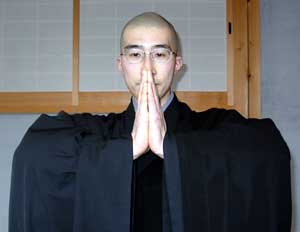 Keishu Sasaki |
1.Gassho Hold the palms and fingers of both hands together. Gassho is an expression of respect, faith and devotion. Because the two hands (duality) are joined together, it expresses the "One-Mind." |
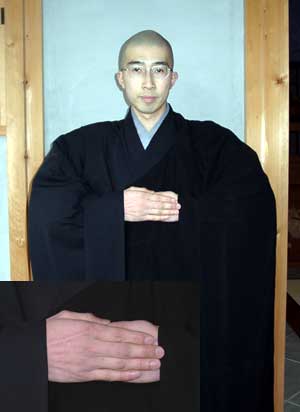 |
2.Shashu Put the thumb of your left hand in the middle of the palm and make a fist around it. Place the fist in front of your chest. Cover the fist with your right hand. Keep your elbows away from your body forming a straight line with both forearms. |
 |
3.Rin'i-monjin It is a greeting to the neighbors on both sides before seating yourself. At your seat, bow in gassho toward the zafu and turn clockwise. |
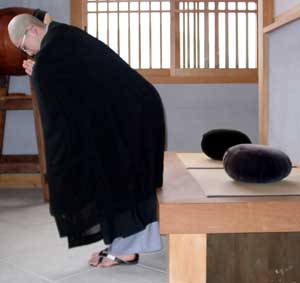 |
4.Taiza-monjin It is a greeting to a neighbor behind you. Bow in gassho toward the man at the back of you. |
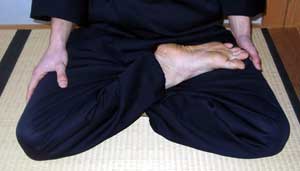  |
5.Kekka-fuza Put your right foot on your left thigh, and your left foot on your right thigh. |
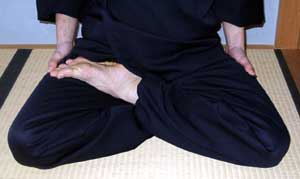  zafu zafu |
6.Hanka-fuza Put just your left foot on your right thigh. |
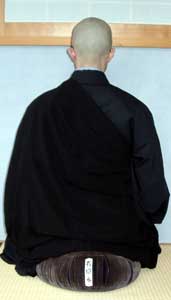 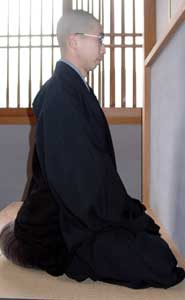 |
7.Posture of the trunk Sit straight, leaning neither to the left nor to the right, neither forward nor backward. |
  |
8.Hokkai-join Place your right hand palm-up on your left foot, and your left hand palm-up on your right palm. The tips of your thumbs should be lightly touching each other. |
 |
9.The eyes Keep your eyes slightly open. Cast them downward at about a 45 angle. Without focusing on any particular thing, let everything have its place in your field of vision. If your eyes are closed, you will easily drift into drowsiness or day-dreaming. |
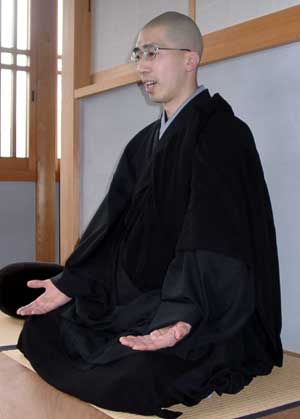 |
10.Kanki-issoku (Exhale completely and take a breath) Quietly make a deep exhalation and inhalation. Slightly open your mouth and exhale smoothly and slowly. In order to expel all the air from your lungs, exhale from the abdomen. Then close your mouth and inhale through your nose naturally. This is called Kanki-issoku. |
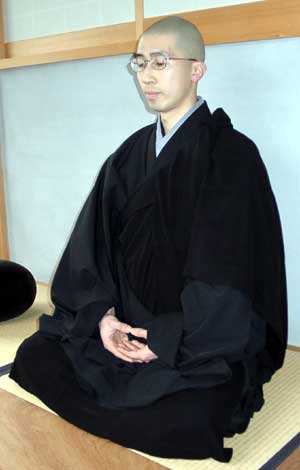 |
11.The mouth Keep your mouth closed, placing your tongue against the roof of your mouth, leaving no air. |
 |
12.Sayu-Yoshin Sway the trunk from side to side, decreasing the angle of the movement until you stop in the center, and sit immovably. Rest the base of your spine in the center of the zafu. |
| 13.Awareness Do not concentrate on any particular object or control your thought. Yet, when you maintain a proper posture and your breathing settles down, your mind will naturally become tranquil as well. When various thoughts arise in your mind, do not become caught up by them or struggle with them; neither pursue nor try to escape from them. Just leave them alone, allowing them to come up and go away freely. The most essential thing in doing zazen is to awaken from distraction (thinking) or dullness(drowsiness) and return to the right posture moment by moment. |
|
| 14.The bell The bell is rung to signal the beginning and end of zazen. When zazen begins, the bell is rung three times (shijosho). When kinhin begins, the bell is rung twice (kinhinsho). And when kinhin is finished, the bell is rung once (chukaisho). Also, when zazen is finished, the bell is rung once (hozensho). |
|
 |
15.Kyosaku It is to warn your carelessness. There are two cases of kyosaku. One is when you order it, the other is when the jikido(who superintends all of people in the hall) gives you it. Bow in gassho when the jikido sets the kyosaku on your shoulder. Lean your head to the left, keeping gassho while being struck. After the jikido hits your shoulder, straighten your head again and bow. The jikido also bows to you as he stands behind you, holding the stick with both hands. |
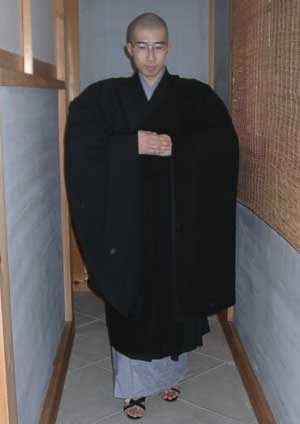 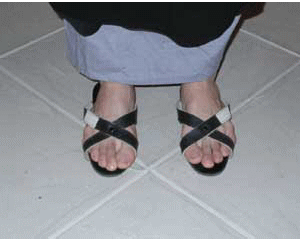 |
16.Kinhin It is to walk slowly in the hall. When kinhinsho rings, hold your hands in shashu. Take half a step for every breath. When chukaisho rings, bow in shashu. Go back to your seat. You can begin zazen again after Rin'i-monjin, Taiza-monjin. |
| 17.Finishing When you finish zazen, bow in gassho, place your hands palms-up on your things, sway your body a few times, first a little, and then more extensively. Take a deep breath. Unfold your legs. Move slowly, especially when your legs are asleep. Do not stand up abruptly. Adjust the shape of your zafu, leave your seat and walk to the entrance as you entered. |
|
The matters to be paid attention 1. Take off accessories, watch and a pair of socks and so on. 2. Spacious clothes are suitable for zazen. 3. Don't walk across the front of the statue. 4. The above-mentioned practice of zazen is the Eigenji style. Everyone can join in Zazen meetings (from 7:30 p.m. every Saturday). If you want to join it, please contact the Eigenji by mail. |
|